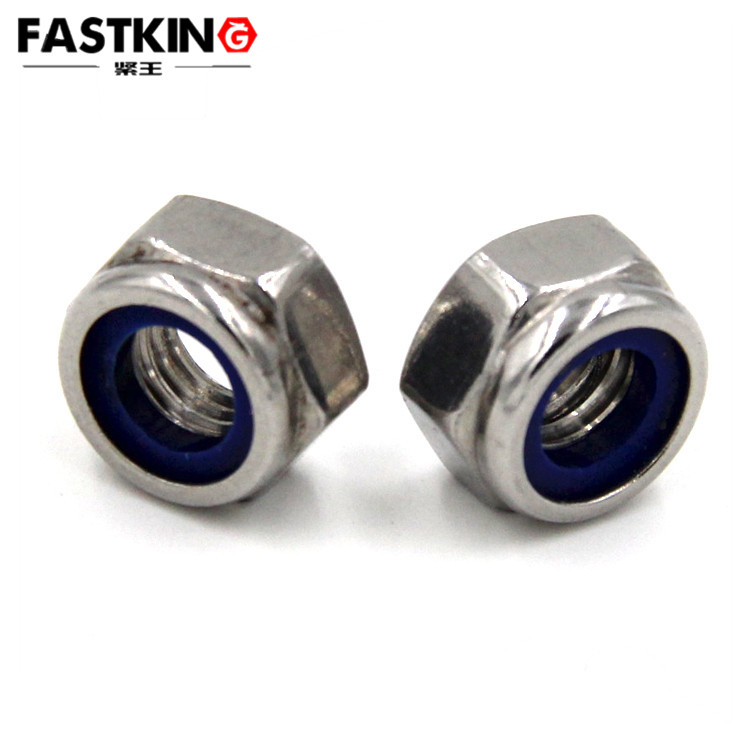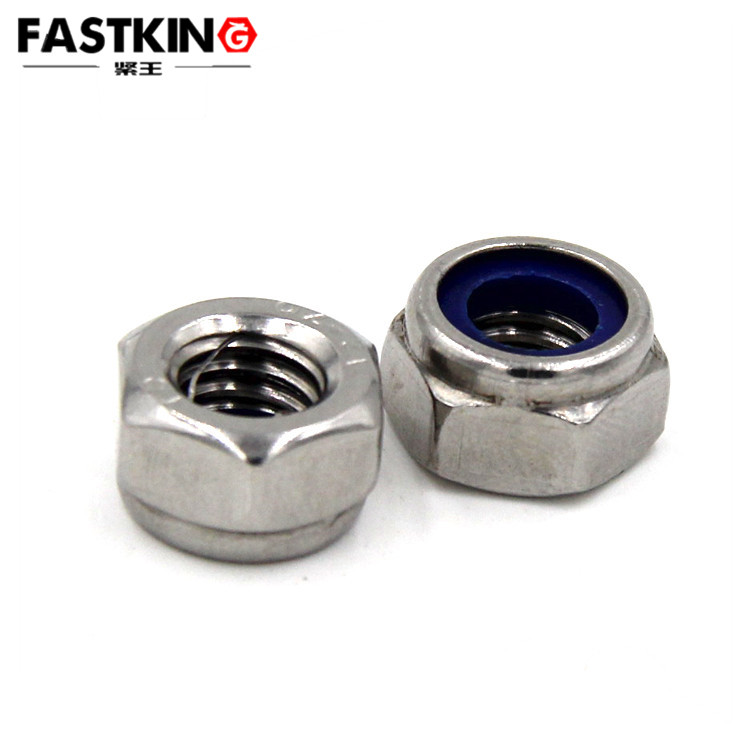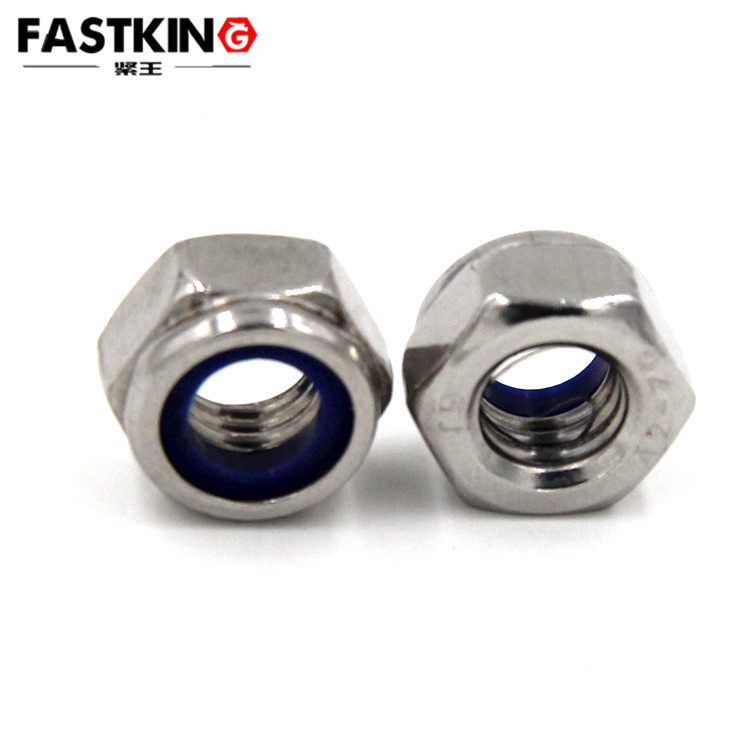- ZHUHAI JIALI HARDWARE CO.,LTD.
- 0760-85889089
Non insert hexagon lock nut-din985
- Product description:The non-metallic insert is inlaid with a layer of non-metallic material (generally nylon 66) around the internal thread of the nut, which plays a locking role after being tightened. It is generally us
Product Definition & Core Features: The "Anti-Loosening Unit" Embedded in Nuts A non-metallic insert is not an independent component, but a core functional part of a nut, forming an integrated structure with the nut body. Its core definition and features can be analyzed from three dimensions:
1. Basic Form: A Non-Metallic Coating Around Internal Threads
The core form of a non-metallic insert is a "layer of non-metallic material attached to the surface of the nut’s internal threads", which is tightly bonded to the nut body typically via injection molding:
- Embedding Position: It is mainly distributed in the middle-rear section of the nut’s internal threads (1/2 to 2/3 of the thread length away from the nut’s end face); some designs cover the entire thread length. The bonding surface between the non-metallic material and the nut body is roughened (e.g., by adding annular grooves) to prevent the non-metallic layer from falling off during use;
- Material Selection: Over 90% of non-metallic inserts use nylon 66, as it has excellent elasticity (elastic modulus of approximately 2.8GPa), temperature resistance (long-term service temperature ranging from -40℃ to 120℃), and corrosion resistance, making it suitable for most civil and industrial scenarios. For high-temperature scenarios (e.g., around engines), modified nylon (such as nylon 66 + glass fiber reinforcement, with temperature resistance increased to 150℃) is used. For strong corrosion scenarios, polytetrafluoroethylene (PTFE) may be used, but its high cost limits its application range;
-
Dimensional Precision: The thickness of the non-metallic layer must be strictly controlled, usually between 0.1mm and 0.3mm (increasing with nut size. For example, the insert thickness of an M5 nut is approximately 0.15mm, and that of an M10 nut is about 0.25mm). This ensures that the bolt can be screwed in smoothly without being too thick, while also preventing the loss of anti-loosening effect due to being too thin.

2. Application Scenarios: Focusing on "Non-Detachable" Stability Requirements
The anti-loosening principle of non-metallic inserts determines their "one-time anti-loosening" property, so they are mainly used in non-detachable or rarely detachable occasions:
- Typical scenarios include the fixing of automotive engine brackets, the locking of screws on motherboards of electronic devices, and the connection of motor end covers in home appliances. In these scenarios, once the nut is installed in place, there is no need for disassembly during subsequent maintenance, and it must withstand long-term working conditions such as vibration and temperature fluctuations. The long-term anti-loosening capability of non-metallic inserts can prevent failures caused by nut loosening;
- In contrast, non-metallic inserts are not suitable for occasions requiring frequent disassembly (e.g., equipment maintenance ports, temporary fixed structures). Each disassembly will further damage the non-metallic layer, leading to a significant decline in the anti-loosening effect or even the complete loss of anti-loosening capability.
3. Matching Relationship: "Exclusive Adaptation" with Specific Nuts
Non-metallic inserts must be designed and produced simultaneously with the nut body to form a dedicated product called "nut with non-metallic insert", rather than a universal accessory:
- The material of the nut body must match the insert. Common combinations include "carbon steel nut + nylon 66 insert" (with galvanized/Dacromet surface treatment for rust resistance, suitable for dry and slightly humid environments) and "stainless steel nut + nylon 66 insert" (suitable for outdoor, humid, or slightly corrosive environments);
- The thread specifications must correspond strictly. The inner diameter of the insert is slightly smaller than the theoretical minor diameter of the nut’s internal thread (with an interference fit of 0.05-0.1mm), ensuring sufficient physical interference when screwing with the bolt (external thread) — a key prerequisite for anti-loosening.
Anti-Loosening Principle: The Whole Process from "Gap Filling" to "Resistance Generation"
The anti-loosening of non-metallic inserts does not rely on a simple increase in friction, but on the "destruction and deformation of non-metallic materials" to build multi-dimensional anti-loosening resistance. The complete anti-loosening process can be divided into three stages:
1. Stage 1: Bolt Screwing-In, "Selective Destruction" of Non-Metallic Materials
When the bolt (external thread) is screwed into the nut with a non-metallic insert, since the inner diameter of the insert is smaller than the minor diameter of the bolt’s thread, the crest of the external thread will exert forced extrusion on the non-metallic layer:
- The part of the non-metallic layer in contact with the thread crest will be "sheared and destroyed", forming a groove matching the thread profile; the untouched parts (thread flanks and roots) remain intact and continue to cover the surface of the internal thread;
- This process is not "irregular wear", but "plastic deformation + local destruction" of the non-metallic material conforming to the thread profile. It ensures the bolt can be screwed in smoothly while laying a structural foundation for subsequent anti-loosening.
2. Stage 2: Thread Matching, Non-Metallic Materials "Filling Gaps"
After the bolt is screwed into place, the damaged non-metallic material will undergo elastic recovery and secondary deformation, completely filling the gaps in the thread fit:
- The fitting gaps of the thread pair (including the flank gap and root gap between the internal and external threads) will be completely filled by the deformed non-metallic material, eliminating the defect of "easy loosening due to gaps" in traditional threads;
-
At the same time, the undamaged non-metallic layer will exert continuous radial pressure (elastic restoring force) on the flanks of the bolt’s thread, keeping the thread pair in a "tight fit" state. Even when the thread expands or contracts due to temperature changes, the elasticity of the non-metallic material can compensate for the gap changes and maintain the fitting pressure.

3. Stage 3: Anti-Loosening Against Rotation, Non-Metallic Materials "Increasing Resistance"
When the nut tends to rotate and loosen relative to the bolt under vibration or external force, the non-metallic insert generates anti-loosening resistance in two dimensions:
- Frictional Resistance: The non-metallic material filling the thread gaps is in close contact with both the bolt and the nut body, significantly increasing the sliding friction of the thread pair and preventing the nut from rotating;
- Mechanical Resistance: The non-metallic groove "extruded and formed" by the thread profile forms an "engagement lock" with the bolt’s thread teeth — like adding tiny "tenons" between the threads. When the nut rotates, it must overcome the shear strength of the non-metallic material to disengage. This resistance is much greater than the friction of traditional nuts, and the anti-loosening effect can be improved by 3-5 times.
Third-party test data shows that in a 1000Hz high-frequency vibration test, ordinary nuts (without anti-loosening measures) showed obvious loosening within 2 hours, while nuts with nylon 66 inserts had a preload loss of less than 5% after 8 hours and no tendency to rotate and loosen.
Core Advantages & Limitations: "Precise Adaptation" to Non-Detachable Scenarios
The anti-loosening solution of non-metallic inserts is not "universal". Its advantages and limitations are closely bound to its "one-time anti-loosening" principle, so it must be selected precisely according to the scenario:
1. Core Advantages: Tailored for Non-Detachable Scenarios
- High Anti-Loosening Reliability: Compared with anti-loosening methods relying on friction (such as spring washers and lock washers), non-metallic inserts use "gap filling + mechanical locking". Their anti-loosening effect is not affected by vibration frequency or temperature fluctuations, and they have stronger long-term stability;
- Simple Structure and Low Cost: No additional accessories such as washers or glue are needed. A single nut can achieve anti-loosening, simplifying the assembly process (only one tightening is required). In addition, materials like nylon 66 are low-cost, resulting in significant cost-effectiveness in bulk applications;
- No Damage to Bolts: The hardness of non-metallic materials is much lower than that of bolts (the hardness of nylon 66 is approximately R110, while that of carbon steel bolts is about HRC25-30). During screwing and anti-loosening, the bolt threads will not be scratched, avoiding a decline in connection strength caused by thread damage.
2. Main Limitations: Unable to Adapt to Frequent Disassembly Scenarios
- Non-Reusable: Each disassembly will further damage the structure of the non-metallic insert (e.g., groove deformation, non-metallic layer falling off). The anti-loosening effect will decrease by more than 50% during secondary installation, or even fail completely. Therefore, it is only suitable for "non-detachable after installation" occasions;
- Limited Temperature and Chemical Resistance: Ordinary nylon 66 inserts will soften in environments exceeding 120℃, leading to a decline in anti-loosening force. When in long-term contact with strong acid or alkali solutions (e.g., hydrochloric acid or sodium hydroxide solutions with a concentration > 10%), the non-metallic material will degrade and lose elasticity;
- Need for Controlled Installation Torque: When screwing in the bolt, a torque wrench must be used to tighten it according to the recommended value (e.g., the recommended torque for an M8 nut with an insert is 20-25N・m). Too small a torque will result in insufficient deformation of the non-metallic material and poor anti-loosening effect; too large a torque may crush the non-metallic layer or deform the nut body.
Typical Application Scenarios: Full Coverage from Consumer Electronics to Industrial Equipment
Relying on the advantages of "reliable anti-loosening + low cost", non-metallic inserts have penetrated into non-detachable scenarios in multiple fields. Typical applications include:
1. Electronics and Consumer Electronics Industry: Anti-Loosening Guarantee for Micro-Connections
- Fixing of Motherboards in Smartphones and Laptops: Miniature nuts with non-metallic inserts (M2-M3) are used. Nylon 66 inserts prevent screws from loosening due to device drops or vibration, avoiding poor motherboard contact;
- Connection of Hard Disk Racks in Server Cabinets: Servers generate slight vibration during long-term operation. Non-metallic inserts can ensure the stable fixation of hard disk racks, preventing data errors caused by loosening during hard disk reading and writing.
2. Home Appliance Industry: Stable Fixing of Motors and Structural Parts
- Motor End Covers of Washing Machines and Air Conditioners: Motors generate high-frequency vibration during operation. Nuts with non-metallic inserts can prevent the end cover screws from loosening, avoiding motor noise or dust ingress;
- Fixing of Inner Liners in Microwaves and Ovens: Although the working temperature is relatively high (around 80-100℃ near the inner liner), it does not exceed the temperature resistance limit of nylon 66. Non-metallic inserts can maintain the anti-loosening effect for a long time, and there is no need to worry about washer failure caused by high temperatures.
3. Automotive Industry: Long-Term Anti-Loosening for Non-Maintenance Parts
- Fixing of Automotive Interior Parts (e.g., Instrument Panels, Door Panel Clips): Interior parts do not require disassembly. Non-metallic inserts can prevent interior loosening and noise caused by vehicle vibration during driving;
- Non-Maintenance Parts Around Engines (e.g., Water Pump Housings): Modified nylon inserts (temperature-resistant up to 150℃) are used to adapt to the high-temperature environment around the engine, ensuring the long-term fixation of the housing and avoiding coolant leakage.
Usage Precautions: "Key Details" to Ensure Anti-Loosening Effect
To give full play to the anti-loosening effect of non-metallic inserts, three key details must be paid attention to during selection and installation:
- Material Matching: Select the insert material according to the service temperature — ordinary nylon 66 for normal-temperature scenarios, glass fiber-modified nylon for high-temperature scenarios (>120℃), and PTFE inserts for strong corrosion scenarios (e.g., chemical equipment);
- Torque Control: Tighten strictly according to the recommended torque for the nut specification (refer to GB/T 3098.9 Mechanical Properties of Fasteners - Prevailing Torque Type Steel Lock Nuts) to avoid insert failure due to under-tightening or over-tightening;
- Scenario Judgment: Clearly confirm that the application scenario is "non-detachable". If regular maintenance is required later (e.g., equipment maintenance ports, detachable panels), other anti-loosening methods (such as metal lock nuts, anti-loosening glue) should be used instead to avoid insert scrapping caused by disassembly.



